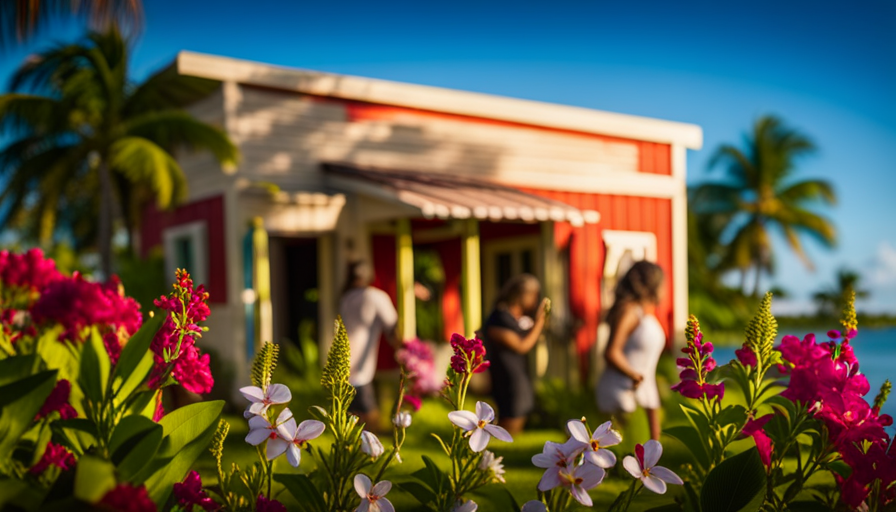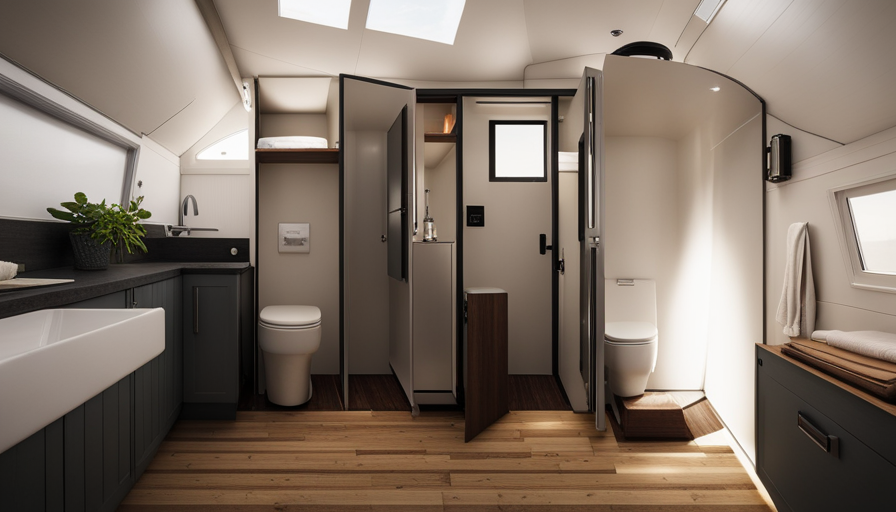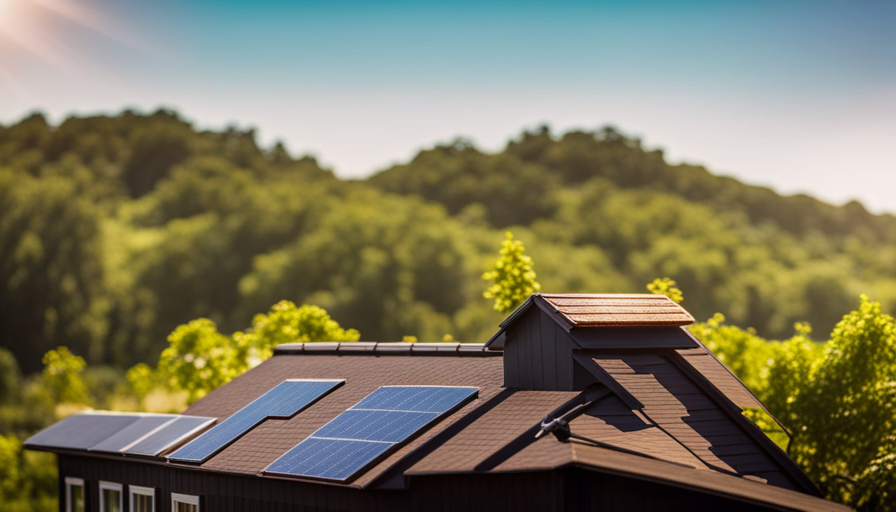Are you ready to embark on an amazing journey that will transform your passion for tiny homes into a tangible reality? Don’t miss out on the ‘6-Weeks Learn How to Build Tiny House Florida’ program.
This immersive and exhilarating experience will equip you with the essential skills and knowledge needed to construct your dream tiny house from start to finish. In just six short weeks, you will master framing techniques, electrical systems, plumbing installation, insulation, roofing, and much more.
Prepare to be amazed as you discover the art of sustainable building practices and the secrets to maximizing energy efficiency. Safety and building codes will also be thoroughly covered, ensuring that you create a safe and compliant living space.
And fear not, for we will guide you through the process of finding land and exploring financing options, making your tiny house dreams a reality. Get ready to embark on the adventure of a lifetime and join us in Florida for the ‘6-Weeks Learn How to Build Tiny House Florida’ program!
Key Takeaways
- Emphasis on sustainable building practices and maximizing energy efficiency
- Hands-on learning approach with experienced professionals as instructors
- Interior design and space optimization are important for functionality and comfort
- Compliance with safety and building codes crucial for a safe tiny house
Program Overview and Duration
The program’s duration is just a few weeks, making it a quick and efficient way to learn how to build a tiny house in Florida. The program structure is designed to provide hands-on learning experience, ensuring that participants gain practical skills and knowledge.
The program starts with an overview of the building process, covering everything from the foundation to the finishing touches. Participants will learn about different framing techniques and construction basics, such as how to properly measure and cut materials, install insulation, and build walls and roofs. The instructors are experienced professionals who guide and assist throughout the program, offering valuable insights and tips.
The hands-on learning approach allows participants to practice what they learn in a real-life setting, reinforcing their understanding and building their confidence. By the end of the program, participants will have acquired the necessary skills and knowledge to successfully build their own tiny house in Florida.
Transitioning into the subsequent section, we will delve into the specific framing techniques and construction basics required for building a sturdy and efficient tiny house.
Framing Techniques and Construction Basics
In this module, I’ll delve into the art of constructing a compact dwelling in the Sunshine State, focusing on framing techniques and the essential foundations of building.
When it comes to framing techniques, it’s important to consider the overall structure and stability of the tiny house. We will explore various methods such as platform framing, balloon framing, and timber framing. Each technique has its own advantages and considerations, and we’ll discuss the best approach for your specific project.
Next, we’ll dive into the construction materials needed for building a tiny house in Florida. From the framing lumber to the sheathing and insulation, we’ll explore the different options available and their suitability for the Florida climate. It’s crucial to choose materials that are both durable and energy-efficient, considering the hot and humid weather conditions.
By the end of this module, you will have a solid understanding of the framing techniques and construction materials required to build a tiny house in Florida. Armed with this knowledge, you’ll be ready to move on to the next section, where we will explore electrical systems and wiring, ensuring your tiny house is not only well-constructed but also fully functional.
Electrical Systems and Wiring
Get ready to embark on a journey through the world of electrical systems and wiring, where sparks fly and circuits come to life in your compact Sunshine State dwelling. When it comes to building your tiny house in Florida, it’s crucial to prioritize electrical safety and adhere to electrical code requirements. This ensures that your electrical system is properly installed and meets the necessary standards.
Electrical safety should always be a top priority during the construction of your tiny house. It’s important to use proper grounding techniques, install circuit breakers, and follow all safety guidelines to prevent any potential hazards. Additionally, it’s essential to understand the electrical code requirements specific to Florida. This includes knowledge of the proper wire sizes, outlets, and switches that must be used in your tiny house.
Proper wiring techniques are also vital to ensure the efficient functioning of your electrical system. This includes correctly connecting wires, using wire nuts to secure connections, and routing wires through appropriate conduits. It’s important to organize and label your electrical wiring to make troubleshooting and future maintenance easier.
As we transition into the subsequent section about plumbing installation and maintenance, it’s crucial to remember that electrical systems and plumbing systems must be installed and maintained separately to prevent any potential issues.
Plumbing Installation and Maintenance
Dive into the world of plumbing and prepare to tackle the tangles and twists of waterworks in your cozy coastal cottage. Plumbing installation and maintenance are essential skills for any tiny house builder.
Here are some key points to consider when it comes to plumbing:
- Plan and design your plumbing system carefully to ensure efficient water flow and minimize potential issues.
- Use sustainable plumbing materials such as low-flow fixtures and water-saving appliances to reduce water consumption and promote environmental responsibility.
- Regularly inspect and maintain your plumbing system to prevent leaks, clogs, and other common problems.
- Familiarize yourself with plumbing troubleshooting techniques to quickly identify and fix issues that may arise.
- Seek professional help for complex plumbing tasks or if you’re unsure about how to address a particular problem.
As you master the art of plumbing, you’ll also want to think about insulation and energy efficiency. Ensuring your tiny house is well-insulated will help maintain a comfortable indoor temperature and reduce energy consumption. From choosing the right insulation materials to sealing any air leaks, it’s important to prioritize energy efficiency in your tiny house construction.
Insulation and Energy Efficiency
Maximizing insulation and ensuring energy efficiency in your cozy coastal cottage will create a comfortable and eco-friendly haven that’ll make you feel snug and proud. When it comes to insulation techniques, there are a few options to consider.
Firstly, you can use spray foam insulation, which provides an airtight seal and helps to prevent heat transfer. Another option is to install fiberglass batt insulation, which is cost-effective and easy to work with. Additionally, you can add insulation to the exterior walls by using rigid foam insulation boards, which provide excellent thermal resistance.
In terms of energy-efficient materials, there are several choices available. For the windows, consider using double or triple-pane glass with low-emissivity coatings to minimize heat loss. Additionally, using insulated doors with weatherstripping will further enhance energy efficiency. When it comes to the roof, opt for reflective roofing materials that can reflect solar heat, reducing the need for air conditioning. Finally, using energy-efficient appliances and LED lighting fixtures will decrease energy consumption.
By implementing these insulation techniques and using energy-efficient materials, your tiny house in Florida will be well-equipped to handle the coastal climate and minimize energy waste.
As we move into the next section on interior design and space optimization, it’s important to consider how these factors can further enhance the functionality and comfort of your tiny house.
Interior Design and Space Optimization
To enhance the functionality and comfort of your coastal cottage, you’ll want to carefully consider interior design and optimize the use of space. When it comes to interior design trends for tiny houses, minimalism is key.
Choose furniture and decor that serve multiple purposes, such as a sofa that can be converted into a bed or a coffee table with hidden storage compartments. This will help maximize small spaces and make your tiny house feel more spacious.
In terms of colors, opt for light and neutral tones to create a sense of openness and airiness. Consider using mirrors strategically to reflect light and create the illusion of a larger space. Additionally, use curtains or blinds that allow natural light to flow in, which can make your tiny house feel brighter and more inviting.
When it comes to storage, think vertically. Use shelves and wall-mounted organizers to make the most of your wall space. Consider built-in storage solutions, such as under-bed drawers or overhead cabinets. This will help keep your tiny house clutter-free and organized.
Interior design plays a crucial role in maximizing the functionality and comfort of your tiny house. By incorporating minimalist design principles, utilizing multipurpose furniture, and optimizing storage, you can create a space that feels spacious and inviting.
Next, we’ll discuss roofing and exterior finishes.
Roofing and Exterior Finishes
When it comes to roofing and exterior finishes, imagine yourself standing outside your coastal cottage, admiring the sleek and modern design with its durable and weather-resistant materials that perfectly blend into the surrounding natural beauty.
The roofing techniques used in building a tiny house in Florida are crucial for ensuring long-lasting protection against the elements. From traditional asphalt shingles to metal roofing, various options are available to suit different preferences and budgets. A well-designed roof not only provides shelter but also adds an aesthetic appeal to the overall look of the tiny house.
In terms of exterior design ideas, there are countless possibilities to explore. From vibrant colors to natural textures, the exterior finishes can truly transform the look of your tiny house. Consider incorporating elements like wood siding, stone accents, or even a living green wall to create a unique and inviting facade. Additionally, incorporating large windows and glass doors not only enhances the visual appeal but also allows ample natural light to flood the interior, making it feel more spacious and open.
As we transition into the subsequent section about sustainable building practices, it is important to note that roofing and exterior finishes play a significant role in achieving an environmentally friendly tiny house. By choosing materials that are energy-efficient, recyclable, and sourced responsibly, we can reduce our ecological footprint while still enjoying the beauty and functionality of our tiny home.
Sustainable Building Practices
Incorporating sustainable building practices is essential for creating an environmentally friendly coastal cottage with a long-lasting and visually appealing exterior.
When it comes to green construction, using eco-friendly materials is key. One option is to utilize reclaimed or recycled materials for the exterior finishes. These materials not only reduce waste but also add a unique charm to the tiny house.
Additionally, choosing low VOC (volatile organic compounds) paints and stains can contribute to better indoor air quality. These paints release fewer harmful chemicals, making them a healthier choice for both the environment and the occupants of the house.
Another important aspect of sustainable building practices is energy efficiency. Installing energy-efficient windows and doors can help reduce heat loss and gain, leading to lower energy consumption. Additionally, incorporating proper insulation throughout the walls, roof, and floor can further enhance the energy efficiency of the tiny house.
To reduce water consumption, consider using water-saving fixtures such as low-flow toilets and faucets. Additionally, incorporating rainwater collection systems can help supply water for irrigation purposes, reducing the reliance on municipal water sources.
By implementing these sustainable building practices, the coastal cottage will not only be environmentally friendly but also cost-effective in the long run.
The next step is to ensure that the construction adheres to safety and building codes, ensuring the integrity and durability of the tiny house.
Safety and Building Codes
Ensuring compliance with safety and building codes is crucial for creating a coastal cottage that isn’t just aesthetically pleasing but is also safe for its occupants. It’s been reported that non-compliant structures are more prone to accidents and pose a higher risk of injury or even fatality.
To start, obtaining the necessary building permits is the first step in ensuring that the construction process meets all legal requirements. These permits are typically issued by the local government and ensure that the structure is built to code, following regulations for things like electrical systems, plumbing, and structural integrity.
Additionally, fire safety is a significant concern when building a tiny house. Incorporating fire-resistant materials and installing smoke detectors and fire extinguishers are essential steps in preventing and minimizing fire-related risks. It’s also crucial to ensure that there are proper escape routes and emergency exits in case of a fire.
Moving forward, turning your dream of building a tiny house into a reality requires finding suitable land and exploring financing options. By conducting thorough research and working with professionals, you can find the perfect location that meets your needs and budget. Exploring financing options such as loans or crowdfunding can help make your dream a reality.
Now, let’s delve into the next section and discover tips for finding land and financing options without delay.
Turning Your Dream into Reality: Tips for Finding Land and Financing Options
To bring your coastal cottage dream to life, you’ll need to discover the perfect plot of land and explore financing options that fit your vision and budget. Here are four tips to help you turn your dream into a reality:
-
Research the area: Start by researching different areas in Florida that align with your vision for a tiny house. Consider factors such as proximity to the beach, local amenities, and zoning regulations. This will help you narrow down your options and find the ideal location for your tiny house.
-
Engage with local real estate agents: Reach out to local real estate agents who specialize in land sales. They can provide valuable insight into available properties and help you navigate the buying process. Be sure to communicate your specific requirements, including size, location, and budget, to ensure they find suitable options for you.
-
Explore financing options: Financing a tiny house can be different from traditional home loans. Research different financing options such as personal loans, RV loans, or even crowdfunding platforms. Look for lenders who specialize in tiny house financing and compare interest rates and terms to find the best fit for your financial situation.
-
Consider alternative options: If purchasing land is not feasible, consider alternative options such as leasing land or joining a tiny house community. These options can provide access to amenities and a supportive community while still allowing you to live in your dream tiny house.
By following these tips and being diligent in your search, you can find the perfect plot of land and financing options to turn your coastal cottage dream into a reality.
Frequently Asked Questions
Can I attend the program remotely or do I have to be physically present in Florida?
Yes, you can attend the program remotely! You don’t have to be physically present in Florida. The program offers remote attendance, so you can learn how to build a tiny house from wherever you are.
Are there any prerequisites or prior experience required to enroll in the program?
There are no prerequisites or prior experience required to enroll in the program. You can join regardless of your background, making it accessible to anyone interested in learning how to build a tiny house.
Will I receive any certification or accreditation upon completion of the program?
Upon completing the program, you will receive a certification that attests to your skills in building tiny houses. This accreditation will validate your expertise and enhance your career opportunities in the field.
Can I bring my own tools and materials for the construction process?
Yes, you can bring your own tools and materials for the construction process. However, please ensure that they meet the tool requirements provided. It is important to have the necessary tools to successfully complete the program.
Is there any ongoing support or guidance provided after the program ends, in case I have further questions or need assistance with my own tiny house project?
Yes, there is ongoing support and program assistance available even after the 6-week program ends. If you have further questions or need assistance with your own tiny house project, you can rely on the support provided.
Conclusion
In conclusion, the 6-week program on learning how to build a tiny house in Florida has provided me with a wealth of knowledge and skills.
From framing techniques to electrical systems, plumbing installation to roofing and exterior finishes, I now feel confident in my ability to construct my own sustainable and energy-efficient home.
The program’s emphasis on safety and building codes has also been invaluable.
Overall, this program has been an incredible journey, exceeding my wildest dreams.
I can’t wait to turn my dream into a reality and find the perfect land and financing options to make it happen.
Hi, I’m Emma. I’m the Editor in Chief of Tiny House 43, a blog all about tiny houses. While tree houses are often associated with childhood, they can be the perfect adult retreat. They offer a cozy space to relax and unwind, surrounded by nature. And since they’re typically built on stilts or raised platforms, they offer stunning views that traditional homes simply can’t match. If you’re looking for a unique and romantic getaway, a tree house tiny house might just be the perfect option.










